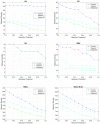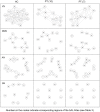Functional interactions in patients with hemianopia: A graph theory-based connectivity study of resting fMRI signal
- PMID: 31905211
- PMCID: PMC6944357
- DOI: 10.1371/journal.pone.0226816
Functional interactions in patients with hemianopia: A graph theory-based connectivity study of resting fMRI signal
Abstract
The assessment of task-independent functional connectivity (FC) after a lesion causing hemianopia remains an uncovered topic and represents a crucial point to better understand the neural basis of blindsight (i.e. unconscious visually triggered behavior) and visual awareness. In this light, we evaluated functional connectivity (FC) in 10 hemianopic patients and 10 healthy controls in a resting state paradigm. The main aim of this study is twofold: first of all we focused on the description and assessment of density and intensity of functional connectivity and network topology with and without a lesion affecting the visual pathway, and then we extracted and statistically compared network metrics, focusing on functional segregation, integration and specialization. Moreover, a study of 3-cycle triangles with prominent connectivity was conducted to analyze functional segregation calculated as the area of each triangle created connecting three neighboring nodes. To achieve these purposes we applied a graph theory-based approach, starting from Pearson correlation coefficients extracted from pairs of regions of interest. In these analyses we focused on the FC extracted by the whole brain as well as by four resting state networks: The Visual (VN), Salience (SN), Attention (AN) and Default Mode Network (DMN), to assess brain functional reorganization following the injury. The results showed a general decrease in density and intensity of functional connections, that leads to a less compact structure characterized by decrease in functional integration, segregation and in the number of interconnected hubs in both the Visual Network and the whole brain, despite an increase in long-range inter-modules connections (occipito-frontal connections). Indeed, the VN was the most affected network, characterized by a decrease in intra- and inter-network connections and by a less compact topology, with less interconnected nodes. Surprisingly, we observed a higher functional integration in the DMN and in the AN regardless of the lesion extent, that may indicate a functional reorganization of the brain following the injury, trying to compensate for the general reduced connectivity. Finally we observed an increase in functional specialization (lower between-network connectivity) and in inter-networks functional segregation, which is reflected in a less compact network topology, highly organized in functional clusters. These descriptive findings provide new insight on the spontaneous brain activity in hemianopic patients by showing an alteration in the intrinsic architecture of a large-scale brain system that goes beyond the impairment of a single RSN.
Conflict of interest statement
The authors have declared that no competing interests exist.
Figures










Similar articles
-
Network topology and functional connectivity disturbances precede the onset of Huntington's disease.Brain. 2015 Aug;138(Pt 8):2332-46. doi: 10.1093/brain/awv145. Epub 2015 Jun 9. Brain. 2015. PMID: 26059655 Free PMC article.
-
Altered Static and Dynamic Functional Network Connectivity and Combined Machine Learning in Stroke.Brain Topogr. 2025 Jan 9;38(2):21. doi: 10.1007/s10548-024-01095-7. Brain Topogr. 2025. PMID: 39789164
-
Functional connectivity of the Precuneus reflects effectiveness of visual restitution training in chronic hemianopia.Neuroimage Clin. 2020;27:102292. doi: 10.1016/j.nicl.2020.102292. Epub 2020 May 26. Neuroimage Clin. 2020. PMID: 32554320 Free PMC article.
-
Dysregulation within the salience network and default mode network in hyperthyroid patients: a follow-up resting-state functional MRI study.Brain Imaging Behav. 2020 Feb;14(1):30-41. doi: 10.1007/s11682-018-9961-6. Brain Imaging Behav. 2020. PMID: 30259292 Review.
-
Mapping the functional connectome in traumatic brain injury: What can graph metrics tell us?Neuroimage. 2017 Oct 15;160:113-123. doi: 10.1016/j.neuroimage.2016.12.003. Epub 2016 Dec 3. Neuroimage. 2017. PMID: 27919750 Review.
Cited by
-
Resting-State Functional Magnetic Resonance Imaging and Functional Connectivity Density Mapping in Patients With Optic Neuritis.Front Neurosci. 2021 Oct 14;15:718973. doi: 10.3389/fnins.2021.718973. eCollection 2021. Front Neurosci. 2021. PMID: 34720858 Free PMC article.
-
Efficacy of Tai Chi on lower limb function of Parkinson's disease patients: A systematic review and meta-analysis.Front Aging Neurosci. 2023 Feb 1;15:1096417. doi: 10.3389/fnagi.2023.1096417. eCollection 2023. Front Aging Neurosci. 2023. PMID: 36819715 Free PMC article. Review.
-
Mechanisms of motor symptom improvement by long-term Tai Chi training in Parkinson's disease patients.Transl Neurodegener. 2022 Feb 7;11(1):6. doi: 10.1186/s40035-022-00280-7. Transl Neurodegener. 2022. PMID: 35125106 Free PMC article. Clinical Trial.
-
Effects of different exercise types on balance function in healthy older adults and Parkinson's patients: a systematic review.Front Aging Neurosci. 2024 Dec 24;16:1411584. doi: 10.3389/fnagi.2024.1411584. eCollection 2024. Front Aging Neurosci. 2024. PMID: 39777047 Free PMC article.
-
Alzheimer's-specific brain amyloid interactome: Neural-network analysis of intra-aggregate crosslinking identifies novel drug targets.iScience. 2023 Dec 18;27(1):108745. doi: 10.1016/j.isci.2023.108745. eCollection 2024 Jan 19. iScience. 2023. PMID: 38274404 Free PMC article.

